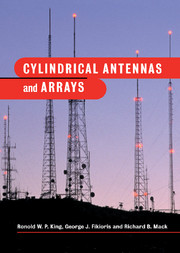Book contents
- Frontmatter
- Contents
- Preface
- Preface to first edition
- 1 Introduction
- 2 An approximate analysis of the cylindrical antenna
- 3 The two-element array
- 4 The circular array
- 5 The circuit and radiating properties of curtain arrays
- 6 Arrays with unequal elements: parasitic and log-periodic antennas
- 7 Planar and three-dimensional arrays
- 8 Vertical dipoles on and over the earth or sea
- 9 Dipoles parallel to the plane boundaries of layered regions; horizontal dipole over, on, and in the earth or sea
- 10 Application of the two-term theory to general arrays of parallel non-staggered elements
- 11 Resonances in large circular arrays of perfectly conducting dipoles
- 12 Resonances in large circular arrays of highly conducting dipoles
- 13 Direct numerical methods: a detailed discussion
- 14 Techniques and theory of measurements
- Appendix I Tables of Ψd R, T(m) or T′(m) and self-and mutual admittances for single elements and circular arrays
- Appendix II Tables of matrix elements Φu and Φυ for curtain arrays
- Appendix III Tables of admittance and impedance for curtain arrays
- References
- List of symbols
- Index
14 - Techniques and theory of measurements
Published online by Cambridge University Press: 07 August 2009
- Frontmatter
- Contents
- Preface
- Preface to first edition
- 1 Introduction
- 2 An approximate analysis of the cylindrical antenna
- 3 The two-element array
- 4 The circular array
- 5 The circuit and radiating properties of curtain arrays
- 6 Arrays with unequal elements: parasitic and log-periodic antennas
- 7 Planar and three-dimensional arrays
- 8 Vertical dipoles on and over the earth or sea
- 9 Dipoles parallel to the plane boundaries of layered regions; horizontal dipole over, on, and in the earth or sea
- 10 Application of the two-term theory to general arrays of parallel non-staggered elements
- 11 Resonances in large circular arrays of perfectly conducting dipoles
- 12 Resonances in large circular arrays of highly conducting dipoles
- 13 Direct numerical methods: a detailed discussion
- 14 Techniques and theory of measurements
- Appendix I Tables of Ψd R, T(m) or T′(m) and self-and mutual admittances for single elements and circular arrays
- Appendix II Tables of matrix elements Φu and Φυ for curtain arrays
- Appendix III Tables of admittance and impedance for curtain arrays
- References
- List of symbols
- Index
Summary
Theory and experiment have run hand-in-hand leading the way toward new concepts and new radiating and receiving structures throughout the history of antennas. Sometimes new antennas were developed through experiment with supporting analysis coming later and perhaps pointing the way to optimization. In other instances, the analysis pointed the way with experiment showing that the analytical model could be achieved in the physically real world. Regardless of the origin of the idea, the most effective results have occurred when the theoretical analysis and the experimental measurements come together. For the experimental and theoretical results to agree, both must describe a model that has exactly the same electromagnetic boundary conditions. Since it is rarely possible to have identical models in the theoretical and the real world, the models must be critically examined, their differences identified, and at least approximately taken into account. Theoretical concepts such as “less than” and “thin” must be reconciled in each experimental model. Similarly, the measurement process must be critically examined to understand exactly what is being measured. Are sampling probes extracting enough power to distort the interference pattern on the transmission line? Are the fields being sampled too close to a discontinuity? Are loop probes being excited only in their basic mode? Finally, there is always the basic question in antenna experiments: “To what in the world are the elements really coupling?”
Measurement procedures on uniform sections of transmission lines have been discussed many times [1–7].
- Type
- Chapter
- Information
- Cylindrical Antennas and Arrays , pp. 475 - 538Publisher: Cambridge University PressPrint publication year: 2002



